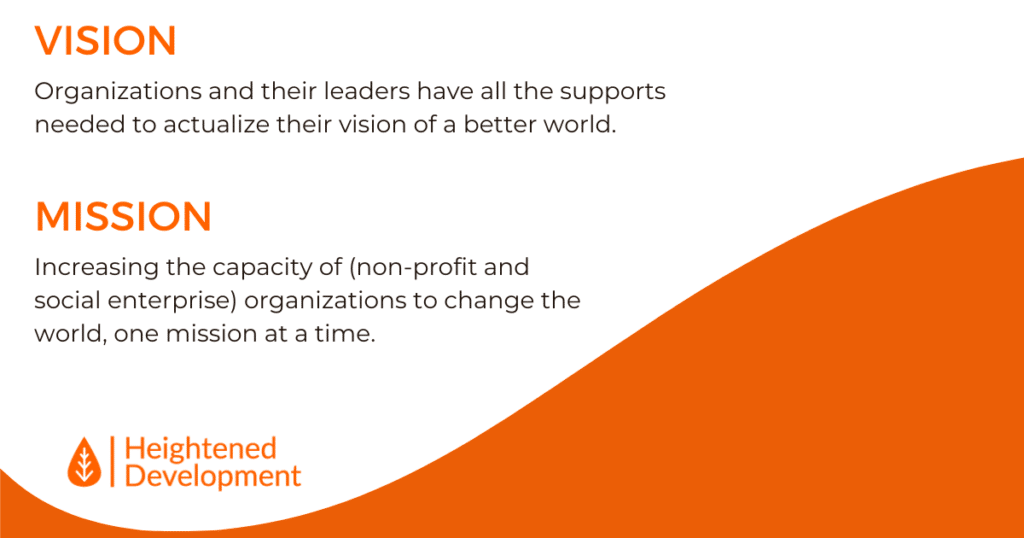What matters when working with nonprofit clients is surprisingly similar to what was needed when leading nonprofits as Executive Director or CEO.
In the past five years, Heightened Development has grown from an idea to an organization building greater impact alongside nonprofit leaders. This is an important mileston since only 43% in this industry survive the five year mark. In the last five years, this has amounted to an impact in 48 unique organizations. It is a privilege to work with so many change-makers. This anniversary is the perfect time to reflect on how Heightened Development’s success as a consulting agency parallels the ingredients needed for success, learning and growth in the nonprofit sector.

Whether an organization is community-based, international, a start-up, or has existed for decades, I find that just like in the nonprofit organizations I led, adding value and deepening impact comes more easily with five priorities. Fortunately, experience working in the nonprofit world provides valuable insights into the journey of building successful organizations. From understanding the importance of organization culture, to keeping your mission central to your work, to knowing when it’s time to scale operations, a few lessons from Heightened Development’s five years of growth are summarized below.
Lesson One: Impact must always be central.
I initially founded Heightened Development because I knew firsthand how exhausting leading in the sector can be, and how much easier it is with skilled professionals around you to sharpen your skills, to allow you to focus on your areas of best expertise, and to help push you toward best practices and innovation. I envisioned truly meeting leaders and organizations where they are, helping them to assess what they need most right now, where to focus, and to help them determine what resources and structure were needed for them to take action on big goals without growing completely exhausted. Over these first five years, I have reflected on what it means to meet organizations where they are and what resources and structure will best provide this support. This is essentially Heightened Development’s “why”.
Over the last 18 months, Heightened Development launched a new website to better articulate this impact, and to share our new vision and mission statements (pictured left).
We all acheive impact only when we spend our time successfully moving the needle on our mission statement. This must include staying focused on why we exist, and in the nonprofit sector this includes what we hope to change. Some key questions I have found important to ask regularly in my daily work are:
- What one to two changes (resources, alignment, restructuring) will most allow this organization to spend more time on the things it does best?
- Where are their structure or system issues that are inhibiting growth or deeper impact?
- What are the right resources and structure for this organization at this stage of development?
- How might I (during the project I was hired to do), help develop leadership capacity within this organization?
These are key in each project Heightened Development engages in because our mission is about serving the sector. For those in the sector, they apply equally well, but the correct answer will be centered around what you hope to impact. For example, what one to two changes will help our “front line” staff spend more time directly with those we serve? Or, do we know what changes we most want to see for those we serve, and do we think that the services we offer have the greatest potential for influencing this? What one or two resources would be a game changer for us?
Lesson Two: Relationships matter; neither impact nor sustainability can exist without them:
When it co
- Relationships can’t be “transactional”, but must include caring about the perspective and well-being of the other person.
- Relationship development requires some level of one-on-one engagement most of the time.
- Staying in front of people in a variety of ways is important (especially prior to making an “ask” of them). This may a variety of things like coffee, personal notes to let others know you care, a newsletter, and/or a listening session.
- Relationships should change or influence our perspectives and thus decision-making.
For nonprofit leaders the list of groups with whom relatonships matter is endless: staff, board, partners, community leaders, donors, and most certainly those served. This list alone is enough to exhaust any nonprofit leader, so the questions that leaders must ask are:
- Who else on our team is positioned to help with relationship development in each of these areas?
- What resources, systems or tranings do they need to better support relationship development?
- If relationship development is at least in part about listening and applying unique perspectives to our work, do we have a way to make sure the feedback provided makes its way back to me as a decision maker, and to share back with our relationships our impact and decisions we have made?
Lesson Three: Your organization’s culture and stage of growth must dictate your operational structure.
The culture and stage of growth of an organization must dictate its operational structure. A start-up organization will require different processes and procedures than an established organization, and the culture of the organization and the leaders will also impact whether or not systems work. At one point in my career I’d spent five years developing the right structure for our organization. Systems were working well. Then, we merged with another entity and the organizational structure, policies and systems no longer worked. The organization doubled in size overnight (people, programs and physical footprint) and the culture shifted. What once worked, no longer worked. In order to continue our impact and to grow, our culture, stage and leadership had to be considered. I will write later this year about organizational stages and culture as these deeply influence what an organization needs.
For Heightened Development, I started the firm based on my own years of experience with plans to be a solopreneur keeping costs lower for clients. While still technically the only full-time team member, meeting client capacity needs also means partnering with other consultants and firms to bring the best resources to each project. Slowly, for Heightened Development, this has meant determining what processes and resources to streamline for better partnerships, and for lower client costs while still individualizing to meet client needs.
For all organizations, assessing the right structure and systems is about finding the right balance between innovation and risk . I recently spoke with another solopreneur consultant who said, “hiring an executive assistant was the scariest investment I ever made because it was such a financial commitment for my small company……but I can now see that it is the one thing that allowed my company to grow more quickly because I can focus on the things that I do well.” I often hear nonprofit leaders say something similar when they hire their first Director of Development, or create their first “C- Suite” role to balance their workload and build organizational capacity.
Lesson Four: Focus is your friend.
Rarely a week goes by that I don’t hear a nonprofit leader talking about exhaustion and irritability, and much of this stems from a feeling that everyone on their teams are feeling the same way. While burnout has long been an issue in the sector, like nearly all fields since COVID, personal well-being is a struggle for us all. Since nonprofit leaders are seeking to solve complex problems, ensuring that they invest time and resources on the things they believe will have the deepest mission impact is imperative. Make sure you have a strategic plan and that it appropriately streamlines the focus of your staff and board. For Heightened Development in the last five years, questions that have helped with focus are:
- Can HD bring the level of expertise to this project that the organization’s mission deserves?
- Based on how we will define success at the end of this project, how should we be spending our time?
- Are there ongoing needs in the sector that appear unmet, for which HD may be a resource? Or, is another organization better positioned to make this impact?
There were times as a nonprofit leader when strategic planning felt like something we “should” do, but the full value of the process was missed in the process chosen. Strategic planning was something I had low on my list of key tools when working with organizations when I started Heightened Development. Most strong leaders have a natural bent toward strategy and could write some form of a strategic plan on their own. When I saw issues in sustainability and organizational structure with most clients, a strategic plan seemed less important. However, I have learned that strategic planning is essential to leaders building the right resources and priorities in alignment with the board and staff team. Focus does not come without clarity and alignment, and a plan written in a vacuum does not build clarity or alignment. I write a little about this here.
Lesson Five: Scarcity is your saboteur.
According to Merriam-Webster, a saboteur is one who practices sabotage. The scarcity mindset of the nonprofit sector is a soapbox for me and one I will write more about in the next year. For now, a few reflections that apply to both the nonprofit sector and Heightened Development’s journey in the last five years as well:
- Determine the true cost of providing your service with quality and base your revenue model on it. In the nonprofit sector there have long been concerns around “overhead” costs and confusion around how to estimate the real cost of providing a service. Consulting is not entirely different. I am sometimes asked if I can provide a service for less. The answer is “no”, this is what it costs to provide this valuable resource to you. With that said, meeting organizations and leaders where they are can mean helping them prioritize what they need most, and adjusting the service and deliverables so they get the most out of their investment.
- Invest in the right resources: Sometimes stretching your financial investment/spending is needed to build the resources that will allow you to reach your stretch goals. This is likely an investment in people or processes/technology.
- Avoid the temptation to say “yes” to things that are not a good fit for your mission or expertise. In the nonprofit sector, this often leads to mission drift and a failure to focus on your biggest impact areas. The same is true in a consultancy. Fear of not having “enough” business can lead to saying “yes” to things that never allow me to hone my expertise and niche, and fail to truly support leaders the way Heightened Development was designed to do.
- Think a little harder about saying “no” when you are doing so in fear of your workload but see a high-potential relationship developing. This is a tough one because it doesn’t mean always say “yes” when a potential partnership is involved. That would result in over-commitment and the lack of focus we have already discussed. However, sometimes saying “yes” creates opportunities for learning and partnership that don’t exist if you stay too narrowly focused or live too much in fear of a full plate.
Thank you for five years. It has now been four years since I have worked directly as a nonprofit leader and relationships with leaders help me understand your needs. Please reach out and let me know where you are struggling and where you are succeeding. I value hearing from you3

